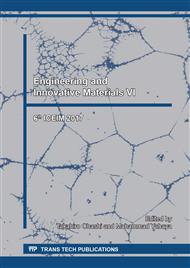p.332
p.337
p.342
p.347
p.352
p.359
p.364
p.369
p.374
The Utilization of Ground Tire Rubber as Ion Exchange Materials
Abstract:
In this study, ground tire rubber (R-GTR) with the average particle size of 456 µm was chemically modified to produce modified ground tire rubber (M-GTR) that can work as ion exchange materials. The modification was performed by oxidation reaction. The ground tire rubber was oxidized at the range of temperature from 20 to 40๐C for 48, 72 and 96 hours by a mixture of the HNO3 /H3PO4/NaNO2 system. The HNO3/H3PO4 ratio was 1:3 and the concentration of NaNO2 was 1.4% w/v. FT-IR revealed that the carboxyl group or the carbonyl group was successfully introduced into the modified ground tire rubber and SEM images demonstrated that the porosity of modified ground tire rubber increased. The results of the modified ground tire rubber showed that the carboxyl content increased with an increase of reaction time while %yield decreased with an increase of reaction time. The optimum condition for modification was the reaction at 30๐C for 96 hours.
Info:
Periodical:
Pages:
352-356
Citation:
Online since:
January 2018
Authors:
Price:
Сopyright:
© 2018 Trans Tech Publications Ltd. All Rights Reserved
Share:
Citation:


